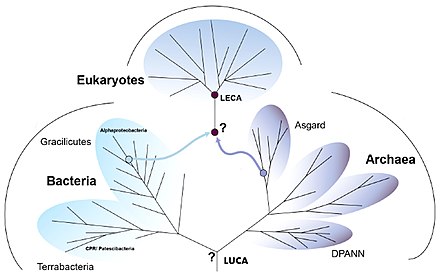Eukaryogenesis
The process is widely agreed to have involved symbiogenesis, in which an archaeon and a bacterium came together to create the first eukaryotic common ancestor (FECA).
It evolved into a population of single-celled organisms that included the last eukaryotic common ancestor (LECA), gaining capabilities along the way, though the sequence of the steps involved has been disputed, and may not have started with symbiogenesis.
In turn, the LECA gave rise to the eukaryotes' crown group, containing the ancestors of animals, fungi, plants, and a diverse range of single-celled organisms.
The last universal common ancestor (LUCA) was an organism which had ribosomes and the genetic code; it lived some 4 billion years ago.
[1][2] The eukaryotes form a domain that contains all complex cells and most types of multicellular organism, including the animals, plants, and fungi.
This enabled it – and the archaeal cells that included it – to survive in the presence of oxygen, which was poisonous to other organisms adapted to reducing conditions.
[8] It is believed to have been a protist with a nucleus, at least one centriole and cilium, facultatively aerobic mitochondria, sex (meiosis and syngamy), a dormant cyst with a cell wall of chitin and/or cellulose, and peroxisomes.
Early in eukaryotic evolution, about 2 billion years ago, organisms needed a solution to the major problem that oxidative metabolism releases reactive oxygen species that damage the genetic material, DNA.
[15] Eukaryotic sex provides a process, homologous recombination during meiosis, for using informational redundancy to repair such DNA damage.
[12] Nick Lane and William Martin have argued that mitochondria came first, on the grounds that energy had been the limiting factor on the size of the prokaryotic cell.

